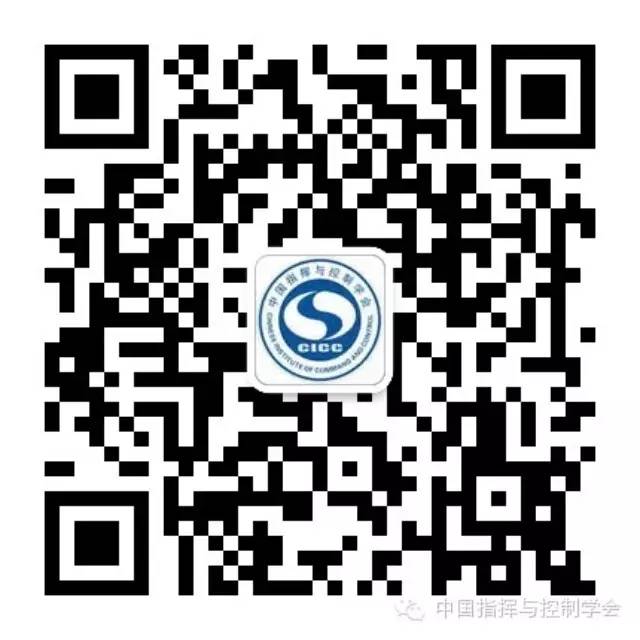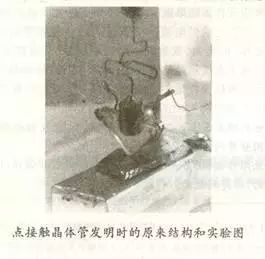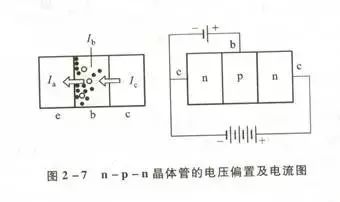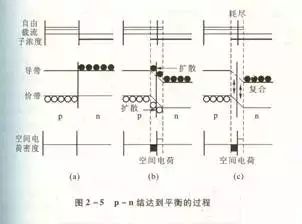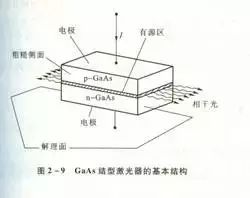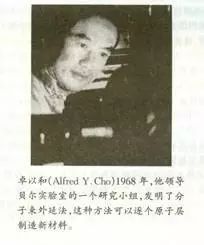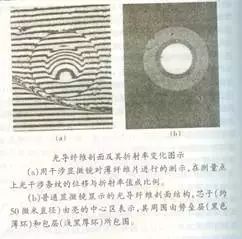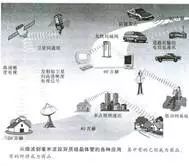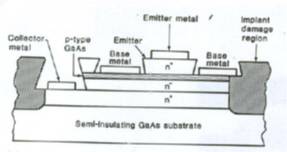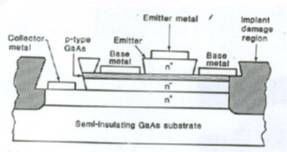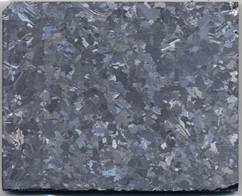
Source: Institute of Semiconductors, Chinese Academy of Sciences
History of Semiconductor Development
Semiconductors are the foundation of information technology.
The invention of large-scale integrated circuits, semiconductor lasers, and various semiconductor devices in the last century played a crucial role in the modern information technology revolution, triggering a new global industrial revolution.
Information technology is a major trend in today’s world economy and social development, and the level of informatization has become an important indicator of the modernization of a country or region.
Entering the 21st century, the world is accelerating the pace of informatization construction.
Driven by the needs of the information technology revolution, semiconductor physics, materials, and devices will experience new and faster developments.
The size of integrated circuits will continue to shrink, and new quantum effect devices will emerge; wide-bandgap semiconductors represent a new direction and will have broad applications in short-wavelength lasers, white light emitting diodes, and high-frequency high-power devices; nano-electronic devices may serve as the next generation of semiconductor microelectronics and optoelectronic devices; using single electrons, single photons, and spintronic devices for quantum control will play a key role in the practical application of quantum computing and quantum communication.
The Invention of the Transistor
In 1945, at the end of World War II, John Bardeen, Walter Brattain, and William Shockley at Bell Labs decided to establish a solid-state physics group to adapt the lab’s work from wartime to peacetime needs.
Shockley and Bardeen were theoretical physicists, Brattain was an experimental physicist, and their combination of skills was a golden pairing for semiconductor physics research and the invention of the transistor.
During World War II, radar detected German bombers, and the core of radar was the vacuum tube, which could amplify weak currents. Shockley had been preparing to create a solid-state device that could amplify current to replace vacuum tubes since 1939.
Bardeen and Brattain created the world’s first germanium point-contact transistor in December 1947, which had current amplification properties.
Although the invention of the point-contact transistor opened the door to the development of transistors, it was not widely adopted due to its complex structure and poor performance.
In January 1948, Shockley invented another type of junction transistor based on his research on p-n junction theory and obtained a patent in June 1948. The junction transistor, also known as the field-effect transistor, is planar and can be mass-produced using planar processes.
Only after the invention of the junction transistor did the advantages of transistors become fully recognized, gradually replacing vacuum tubes.
Due to the contributions of Bardeen, Brattain, and Shockley in the invention of transistors and junction transistors, they were awarded the Nobel Prize in Physics in 1956. The first application of semiconductor transistors was in Sony’s portable radio, which became a global sensation and generated significant profits.
The Invention of Integrated Circuits
Transistor radios were much smaller than vacuum tube radios and portable. However, they were still made up of transistors, resistors, capacitors, and magnetic antennas soldered onto a circuit board, which was still quite large and complicated to assemble.
In 1958, the U.S. government established a fund for miniaturizing transistor circuits to meet the need for launching the first artificial satellite to catch up with the Soviet Union. At that time, Jack Kilby from Texas Instruments undertook this task, attempting to create a miniaturized circuit that packaged transistors, resistors, and capacitors together.
In September 1958, Kilby created the world’s first integrated circuit oscillator, which he recorded in his notes that day. Kilby’s integrated circuit was patented in February 1959, named “miniaturized electronic circuit.”
At the same time, Robert Noyce of Fairchild Semiconductor proposed using aluminum to connect transistors. Just five months after Kilby’s invention of the integrated circuit, Noyce used a planar transistor method to create a mask of SiO2 on the entire silicon wafer, applying photolithography to etch windows and lead paths, diffusing impurities through the windows to form the emitter, base, and collector, and evaporating gold or aluminum to create the integrated circuit. Noyce’s integrated circuit was patented in July 1959, named “semiconductor devices and lead structures.” From then on, integrated circuits entered a new period of large-scale development.
The Invention of Solar Cells
For the needs of artificial satellites, in 1954, Pearson and Fuller used diffusion technology of phosphorus and boron to create large-area silicon p-n junction solar cells with a photoelectric conversion efficiency of over 6%, exceeding the best previous solar cell efficiency by 15 times. Its low production cost enabled mass production, leading to widespread application.
The working principle of solar cells is the photovoltaic effect. When light shines on a semiconductor, electron-hole pairs are generated in the semiconductor. If the external circuit is connected, current will flow, which is the photovoltaic effect.
The commercial application of solar cells began in 1958 when they were selected as the power source for the radio transmitter of the first artificial satellite, Vanguard I. In the current energy crisis, solar cells have attracted significant attention as a renewable and pollution-free power source.
The Invention of Semiconductor Lasers
The working principle of semiconductor light-emitting diodes and lasers is the opposite of solar cells: solar cells generate electricity from light, while light-emitting diodes and lasers generate light from electricity. By injecting current, electrons and holes are introduced into the conduction and valence bands of the semiconductor, respectively. When electrons and holes recombine, they produce photons.
In 1962, Hall in the United States created the first semiconductor laser using p-n homojunctions. To generate laser light, three conditions must be met: inverted population distribution, a resonant cavity, and current exceeding a certain threshold.
In 1963, Kremer in the U.S. and Alferov in the Soviet Union independently created heterojunction lasers, where the junction region used a material with a smaller bandgap, such as GaAs, while the p and n regions used materials with larger bandgaps, such as AlxGa1-xAs. This design significantly improved the light-emitting efficiency and reduced the threshold current of the laser. In 1970, the Soviet Union’s Yofe Institute and Bell Labs in the U.S. each created continuous-wave double heterojunction lasers that operated at room temperature, leading to widespread applications of semiconductor lasers in optical communication.
Due to the significant contributions of Kremer and Alferov in the development of semiconductor lasers, they, along with Kilby, were awarded the Nobel Prize in Physics in 2000. The invention of silicon large-scale integrated circuits and semiconductor lasers ushered the world into an information age based on microelectronics and optoelectronics, greatly promoting social and economic development.
The Invention of Molecular Beam Epitaxy Technology
A key technology for manufacturing double heterojunction lasers is molecular beam epitaxy. In 1968, at Bell Labs, it was discovered that by finely controlling the size and timing of the beam flow in an ultra-high vacuum chamber, different layers and types of semiconductor materials could be grown as needed, leading to the invention of molecular beam epitaxy technology.
The device operates under ultra-high vacuum conditions (10^-10 torr), with a source of raw material elements (such as Ga, As, Al, etc.) in the evaporation furnace. A controllable shutter allows evaporated source atoms to be directed onto a heated substrate for epitaxial growth. Currently, this technology allows for the growth of single atomic layers, and the device is surrounded by various detection instruments to monitor the growth process.
Applications of Semiconductor Technology
Large-Scale Integrated Circuits and Computers
Large-scale integrated circuits laid the foundation for the development of computers and networks. According to Moore’s Law, the integration level of integrated circuits doubles every 18 months, and recently, its line width has reached several tens of nanometers, with each chip containing hundreds of billions of components.
Computer science has reached a high level; both hardware and software are mature, with computers capable of performing trillions of calculations per second (e.g., Tianhe: 20 trillion calculations, the second fastest in the world), providing powerful tools for high-speed computing and massive information processing and conversion.
Since the birth of computers in 1943, due to the invention of integrated circuits, computers have rapidly developed towards higher computing speeds and miniaturization. Currently, major developed countries and China have large-scale computers capable of over 100 trillion floating-point operations. China ranks second in the world in the number of such supercomputers, second only to the United States.
These supercomputers can be used for protein analysis, drug development, and military simulations of nuclear explosions and code-breaking. It should be noted that China is still lagging in the large-scale integrated circuits required to manufacture these computers, with most still needing to be imported.
Optical Communication Technology
Previously, long-distance communication relied on long-distance telephones or telegrams, which were expensive due to the limited number of calls. In 1966, Kao from the British Standard Communication Laboratory proposed using high-purity, high-transparency optical fibers to transmit laser signals. If the loss could be reduced to 20 dB/km, long-distance optical communication could be achieved.
In 1970, Maurer from Corning Glass Works used a deposition process to create dense glass tubes from silicon tetrachloride vapor through flame hydrolysis, which were then heated and drawn into fine optical fibers. The birth of low-loss optical fibers marked a milestone in optical communication technology.
In 1976, Bell Labs conducted the first field experiment of optical communication in Atlanta, achieving excellent results, with average power loss of 6 dB/km and error-free transmission of information over 10.9 km, equivalent to 17 loops around an optical fiber. In December 1976, Bell Labs announced that optical wave communication had passed its first test, proving the feasibility of optical communication and marking the dawn of the optical communication era.
Today, telecommunications networks, computer networks, and cable television networks have become vital infrastructure for a country, with all political, economic, military, scientific, and daily activities relying on these three networks. China currently has 850 million telephone users, including 480 million mobile phone users, making it the largest telecommunications network in the world. The number of computer internet users has reached 137 million, and cable television users reached 130 million, accounting for one-third of the world.
The future trend is the integration of these three networks. Mobile internet access has become quite common, with Apple’s iPhone leading the way in this area.
Light has different colors and wavelengths; not all colors can propagate in optical fibers. The loss of optical fibers has minimum values at 1450-1550 nm and 1250-1350 nm, making them the two main windows for optical fiber communication. To maximize the information channels that an optical fiber can carry, wavelength-division multiplexing systems are used, dividing these two bands into narrow wavelengths, each forming a certain communication capacity. Different wavelength signals are transmitted through a single fiber, then demultiplexed, and the original telecommunication signals transmitted at different wavelengths are restored by photodetectors. Since optical signals gradually attenuate during transmission, optical signals need to be amplified using erbium-doped fiber amplifiers at regular intervals to achieve long-distance transmission.
Wireless Communication Technology (Mobile Phones)
Wireless communication is based on cellular mobile phones, with the early system being the Advanced Mobile Phone Service (AMPS) launched by Bell Labs in 1978. This system divides the service area into many small hexagonal geographic areas, like a honeycomb (see Figure 19). Each cell contains a low-power wireless phone transmitter, receiver, and a control system, forming a base station.
Base stations in each service area are connected to a central switching entity (mobile telephone exchange) via optical fibers, which houses an electronic switching system. The base station network tracks the location of mobile terminals, and when a mobile terminal reaches another cell, it can automatically reconnect with the neighboring base station to continue the call. Because the wireless call power within a cell is low, it only affects a limited range, thus preventing interference with communication signals from other cells.
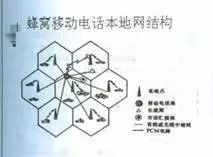 The first AMPS system was successfully tested in Chicago in July 1979. In April 1992, AT&T’s Microelectronics Group announced the development of integrated circuit chips for the next generation of digital cellular phones, making the company a leading supplier of digital signal processing components for mobile communications. This digital signal processor constituted the DSP1600 series, significantly reducing the size and power of mobile phones, making them very popular in the market.
In addition to mobile phone communication, there are other wireless communication methods (see Figure 20), including satellite transmission of high-definition television, inter-satellite communication, multipoint video communication, wireless local area networks, communication between vehicles, and anti-collision radar, all operating in the microwave frequency range from several GHz to 100 GHz.
Various wireless communication methods and their operating frequencies span from microwaves to millimeter waves, with frequencies ranging from 20-80 GHz.
The most critical devices in wireless communication are semiconductor high-frequency oscillators, currently comprising two types: High Electron Mobility Transistors (HEMT) and Heterojunction Bipolar Transistors (HBT). These are typical transistors, but due to the use of molecular beam epitaxy technology, each layer of the n-p-n structure can be made very thin, shortening the path of electron movement and achieving high cutoff frequencies (fT). Currently, both types of devices have reached cutoff frequencies exceeding 100 GHz, meeting the needs of wireless communication.
Cross-section of an npn bipolar transistor
The first AMPS system was successfully tested in Chicago in July 1979. In April 1992, AT&T’s Microelectronics Group announced the development of integrated circuit chips for the next generation of digital cellular phones, making the company a leading supplier of digital signal processing components for mobile communications. This digital signal processor constituted the DSP1600 series, significantly reducing the size and power of mobile phones, making them very popular in the market.
In addition to mobile phone communication, there are other wireless communication methods (see Figure 20), including satellite transmission of high-definition television, inter-satellite communication, multipoint video communication, wireless local area networks, communication between vehicles, and anti-collision radar, all operating in the microwave frequency range from several GHz to 100 GHz.
Various wireless communication methods and their operating frequencies span from microwaves to millimeter waves, with frequencies ranging from 20-80 GHz.
The most critical devices in wireless communication are semiconductor high-frequency oscillators, currently comprising two types: High Electron Mobility Transistors (HEMT) and Heterojunction Bipolar Transistors (HBT). These are typical transistors, but due to the use of molecular beam epitaxy technology, each layer of the n-p-n structure can be made very thin, shortening the path of electron movement and achieving high cutoff frequencies (fT). Currently, both types of devices have reached cutoff frequencies exceeding 100 GHz, meeting the needs of wireless communication.
Cross-section of an npn bipolar transistor
Silicon Materials for Solar Cells
Silicon materials for solar cells mainly include: single crystal silicon, amorphous silicon, ribbon silicon, and thin-film polycrystalline silicon, with efficiencies shown in Figure 22.
Currently, cast polycrystalline silicon accounts for 47.54% of solar cell materials, making it the most important solar cell material. By 2004, the market share of cast polycrystalline silicon exceeded 53%. Single crystal silicon accounted for 35.17%, ranking second, while amorphous silicon thin films accounted for 8.3%, ranking third, and compound semiconductors CuInSe and CdTe only accounted for 0.6%.
Efficiency of solar cells made from different semiconductor materials in laboratories and industries
Polycrystalline Silicon Solar Cells
Until the 1990s, the solar photovoltaic industry was primarily based on single crystal silicon. Although the cost of single crystal silicon cells has been continuously decreasing, they still lack competitiveness compared to conventional electricity, and thus, continuously reducing costs is the goal pursued by the photovoltaic community.
Since the invention and application of cast polycrystalline silicon in the 1980s, it has grown rapidly. It has continuously captured market share from single crystal silicon due to its relatively low cost and high efficiency, becoming the most competitive solar cell material. By the early 21st century, it accounted for over 50%, becoming the primary solar cell material.
Optical photograph of cast polycrystalline silicon wafers
By now, the weight of cast polycrystalline silicon ingots has reached 300 kg, and the size of solar cell wafers has reached 210×210 mm². By the early 21st century, the efficiency of polycrystalline silicon solar cells reached 20.3%. In actual production, the highest efficiency of cast polycrystalline silicon solar cells has also reached about 17.7%, approaching the photoelectric conversion efficiency of single crystal silicon solar cells.
Amorphous Silicon Thin-Film Solar Cells
Today, amorphous silicon thin-film solar cells have developed into one of the practical and inexpensive types of solar cells, with considerable industrial scale. The total production capacity of amorphous silicon solar cells worldwide has reached over 50 MW per year, with sales of components and related products exceeding $1 billion. Their applications range from small devices like watches and calculators to large-scale independent power stations of 10 MW, playing an important role in the development of solar photovoltaic technology.
Compared to crystalline silicon, amorphous silicon thin films have advantages in preparation processes, low costs, and the ability for large-scale continuous production. In the field of solar cells, these advantages manifest as:
(1) Low material and manufacturing process costs. This is because amorphous silicon thin-film solar cells are prepared on inexpensive substrate materials such as glass, stainless steel, and plastic, which are low-cost; furthermore, amorphous silicon thin films are only several thousand angstroms thick, less than one percent of the thickness of crystalline silicon cells, greatly reducing the cost of silicon raw materials; additionally, amorphous silicon is prepared at low temperatures, with deposition temperatures of 100℃~300℃, resulting in low energy consumption during large-scale production, significantly lowering costs.
(2) Easy to achieve large-scale production capacity.
(3) Variety and versatility.
(4) Easy to realize flexible cells. Amorphous silicon can be prepared on flexible substrates, and its special mechanical properties allow it to be made into lightweight, flexible solar cells that can be easily integrated with buildings and various daily products.
However, compared to crystalline silicon, amorphous silicon solar cells have relatively low efficiency, with stable maximum conversion efficiency in laboratory cells only around 16%; in actual production lines, efficiency does not exceed 10%; furthermore, the photoelectric conversion efficiency of amorphous silicon solar cells significantly deteriorates under long-term exposure to sunlight, and this issue has not yet been fundamentally resolved.
Additionally, there are compound solar energy stacking batteries for military and satellite applications.
Semiconductor White Light Lighting
➤1. Significance of Developing Semiconductor White Light Lighting
Gallium nitride light-emitting diodes (LEDs) are efficient, long-lasting solid-state light sources. Incandescent and fluorescent lamps are currently the most widely used traditional white light sources. Incandescent lamps are thermal light sources (color temperature 2800K) that emit a lot of infrared light, have short lifespans, and low luminous efficiency, while fluorescent lamps are cold light sources with high efficiency but short lifespans and toxicity (contain mercury). Compared to traditional incandescent and fluorescent lamps, gallium nitride LEDs are solid-state lighting cold light sources with characteristics such as small size, lightweight, low voltage, high efficiency, and long lifespan, making them energy-saving and environmentally friendly lighting sources.
Gallium nitride LEDs are now used in many applications: landscape lighting, traffic lights, automotive tail lights, and large-screen displays.
Energy is an essential factor for the sustainable development of the economy and society, and saving energy and improving energy efficiency are major strategies for sustainable energy development. Statistics show that global “lighting” consumes about 20% of total electrical power. Due to the high efficiency of LEDs, LED white light lighting can save a significant amount of coal and oil usage for power generation, reducing global CO2 emissions by 2.5 billion tons annually.
Therefore, gallium nitride LED white light lighting has enormous market potential. Once cost and efficiency issues are resolved, it could replace the currently widely used incandescent and fluorescent lamps, triggering a revolution in white light lighting technology. The international community has set a mid-term goal for semiconductor lighting sources (within 5-10 years) to achieve >100 lm/W, aiming for 200 lm/W or 300 lm/W by 2020, thus enabling the replacement of traditional lighting.
➤2. Technical Approaches for Gallium Nitride LED White Light Lighting
As is well known, white light can be synthesized from the three primary colors: red, green, and blue, as shown in Figure 24. This diagram represents the 1931 chromaticity diagram, with the dashed area in the center of the triangle representing the white light area. Gallium nitride LEDs generally emit light of only one color. White light illumination must also be achieved through the synthesis of the three primary colors (RGB). The RGB primary colors can be directly emitted by LEDs or can be obtained by exciting fluorescent materials with LEDs, resulting in secondary light conversion to achieve the three primary colors or quasi-primary colors.
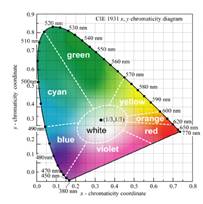
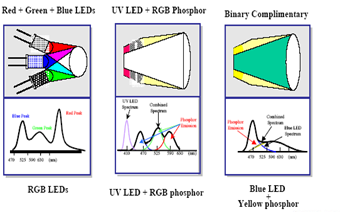 Thus, there are two technical approaches to achieving gallium nitride LED white light lighting: one is to use gallium nitride light-emitting diodes (LEDs) to excite fluorescent materials to convert to white light, referred to as “secondary light conversion white light technology”; the other is to directly emit white light using LEDs, referred to as “direct emission white light technology.”
➤3. Development Directions for LED White Light Lighting Technology
(1) Research and develop near-ultraviolet and deep-ultraviolet LED devices to achieve high color rendering index “solid-state white fluorescent lights.” This white light technology has characteristics such as high color rendering index (CRI >90), high conversion efficiency (external quantum efficiency 43%), and high color reproduction, making it an ideal white light source.
(2) Research and develop III-nitride LEDs for direct emission of white light technology.
(3) Research to improve LED luminous efficiency, light output, and develop power-type LED devices.
Traditional incandescent lamps have a luminous efficiency of 16 lm/W, while fluorescent lamps have a luminous efficiency of 85 lm/W; therefore, III-nitride LED white light lighting sources must achieve luminous efficiency of at least 100 lm/W to replace incandescent and fluorescent lamps while also reducing costs.
Thus, there are two technical approaches to achieving gallium nitride LED white light lighting: one is to use gallium nitride light-emitting diodes (LEDs) to excite fluorescent materials to convert to white light, referred to as “secondary light conversion white light technology”; the other is to directly emit white light using LEDs, referred to as “direct emission white light technology.”
➤3. Development Directions for LED White Light Lighting Technology
(1) Research and develop near-ultraviolet and deep-ultraviolet LED devices to achieve high color rendering index “solid-state white fluorescent lights.” This white light technology has characteristics such as high color rendering index (CRI >90), high conversion efficiency (external quantum efficiency 43%), and high color reproduction, making it an ideal white light source.
(2) Research and develop III-nitride LEDs for direct emission of white light technology.
(3) Research to improve LED luminous efficiency, light output, and develop power-type LED devices.
Traditional incandescent lamps have a luminous efficiency of 16 lm/W, while fluorescent lamps have a luminous efficiency of 85 lm/W; therefore, III-nitride LED white light lighting sources must achieve luminous efficiency of at least 100 lm/W to replace incandescent and fluorescent lamps while also reducing costs.
Optical Disc Storage and Laser Ranging, Laser Printing, Laser Instruments
Optical disc storage and laser ranging, laser printing, and laser instruments are another significant application area for semiconductor lasers. The lasers used for CD (Compact Disc) and DVD (Digital Versatile Disc) have wavelengths of 780 nm and 670 nm, respectively, with lasers writing information onto the disc or reading audio or optical signals from the disc. The shorter the wavelength of the laser, the higher the storage density of the optical disc. The InGaN laser with a wavelength of 410 nm can significantly increase the storage capacity of optical discs. The InGaAlP laser with wavelengths of 670-630 nm has replaced He-Ne lasers in many applications, achieving significant applications in laser ranging, laser printing, and laser medical instruments.
Military Applications of Semiconductor Lasers
The AlGaAs high-power laser with a wavelength of 808 nm serves as a pump light source for high-power YAG (Yttrium Aluminum Garnet) solid-state lasers, replacing the previous xenon gas lasers, eliminating the bulky power supply and cooling system, making solid-state lasers more efficient, compact, high-performance, and cost-effective, suitable for military applications such as laser radar and nuclear explosion simulations, as well as nuclear fusion research. The underwater light transmission window is at 590 nm, and the advent of blue-green laser technology has opened up possibilities for underwater communication. The most critical device in fiber optic gyroscopes, which are used to determine the direction during the flight of rockets and aircraft, is the semiconductor superradiant light-emitting diode.
The sensitive absorption peaks of gases such as water vapor, methane, ammonia, carbon dioxide, carbon monoxide, hydrochloric acid, bromine, and hydrogen sulfide in nature range from 1.5 to 2.0 mm. Quantum well lasers made from InAsSb or GaInAsSb can reach wavelengths of 1.0-4.0 mm, and the recently developed quantum cascade lasers can reach wavelengths of 4.0-17 mm. These various lasers covering the infrared to far-infrared range serve as environmental monitoring guardians.
Future Development of Semiconductor Technology
The Revolution of Information Technology
Information transmission. The explosive increase in information volume has raised the demand for the capacity of information channels. What is transmitted online is not only text but also music, images, television signals, etc.; not only wired but also wireless; not only intercontinental, international, and intercity but also local networks. Therefore, new communication systems such as Integrated Services Digital Network (ISDN) and multimedia technology need to be developed.
Information processing, including text processing, knowledge processing, image processing, language recognition, image recognition, and intelligent processing. Artificial intelligence has achieved certain human intelligence through computers. For example: understanding and producing language, recognizing images, performing mathematical proofs, playing chess, composing music, conducting professional appraisals, and medical diagnoses. Computers will liberate people from part of their daily mental labor and expand human wisdom to previously unimaginable levels through the application of “thinking tools.”
Higher Integration Levels
The mainstream processes of integrated circuits will go through four development stages: 65 nm (integrated circuit line width) in 2007, 45 nm in 2010, 33 nm in 2013, and 22 nm industrial production in 2016. To achieve this, a series of key technologies and specialized equipment must be addressed, such as the research and development of new devices (non-traditional CMOS devices, new types of memory, logic devices, etc.), IC design, packaging, testing technology, and new photolithography, etching, and supporting equipment.
The size of semiconductor devices cannot be reduced indefinitely; if the device size approaches the de Broglie wavelength of electrons (10 nm), quantum effects will become more pronounced, necessitating the design of new types of semiconductor devices based on quantum mechanics principles.
Semiconductor Optoelectronic Devices
Semiconductor optoelectronic devices are developing towards longer and shorter wavelengths, higher power, and higher operating frequencies.
High-power laser array quasi-continuous (QCW) devices and continuous (CW) devices can be used not only as pump sources for solid-state lasers but also directly for material processing, medical applications, instrumentation, sensitive technologies, and printing, entering markets traditionally dominated by non-semiconductor lasers, replacing gas and solid lasers. AlGaN/GaN heterojunction bipolar transistors have good linearity, large current capacity, and uniform threshold current, primarily used in high-power microwave systems where linearity is critical, such as military radar and communication; they can also be applied in systems such as intelligent robots that operate in harsh environments.
Integrated Optics and Integrated Optoelectronics
Systems composed of lasers, modulators, waveguides, gratings, prisms, and other passive optical components integrated on semiconductor films are called integrated optical systems. Integrated optical systems replace electrical interconnections with optical interconnections, offering advantages such as wide bandwidth, large information capacity, low loss, high speed, parallel processing, and resistance to electromagnetic interference in computer and communication systems. Silicon materials are low-cost and widely used in microelectronic devices. However, since they are indirect bandgap materials, they cannot be used as light-emitting devices. Scientists are currently working on solving the light source issue to achieve optoelectronic integration on silicon materials.
Semiconductor Superlattice and Quantum Wire, Quantum Dot Devices
Semiconductor superlattices, quantum wires, and quantum dots are low-dimensional structures that possess special physical properties such as quantum confinement effects and two-dimensional or one-dimensional characteristics of electron motion, enabling the fabrication of excellent devices such as lasers, high electron mobility devices, optical bistable devices, and resonant tunneling devices. When the size and dimensions of devices are further reduced, resulting in the average free path of electrons being greater than the device size, electrons will move in a coherent wave motion without being scattered by impurities or lattice vibrations.
Utilizing these characteristics, it is expected to manufacture ultra-high-speed, ultra-low power consumption electronic devices. For example, quantum dot single-electron transistors will significantly reduce the power consumption of dynamic random access memory (DRAM).
Semiconductor Quantum Information Devices
Current technology can already generate and detect single photons on semiconductor quantum dots, making them the most promising solid devices for quantum information processing (quantum computing, quantum communication). The rapid development of quantum information science and technology provides revolutionary theoretical and experimental methods for precision measurement, quantum computing, and secure communication. The key to quantum information is the coherence of photons.
As the most fundamental quantized entity in quantum theory, photons can easily realize the entire process of collecting, transmitting, replicating, storing, and processing information, possessing unique inherent advantages as carriers of quantum communication and quantum computing. Therefore, photon-based quantum information processing devices form the foundation for various quantum information engineering, and their fundamental principle research and fabrication will undoubtedly lead to a leap in computational science and communication capabilities.
Currently, microelectronic devices use charge carriers to carry information. If a material can utilize both the charge and spin properties of carriers as information carriers, devices with non-volatile, low-power, high-speed, and high integration advantages could be manufactured, potentially causing significant changes in electronic information science. Diluted magnetic semiconductors with magnetic ions and spintronics have emerged to meet this requirement.
Experiments have shown that spin coherence times in semiconductors have reached the ns level, far exceeding the coherence time of charge carriers, indicating the promising application prospects of spintronics in future quantum computing and quantum communication. The main challenge in realizing spin-based quantum computers is the precise control and maintenance of spin coherence; thus, many physical problems need to be researched and resolved regarding how to generate spin-coherent electronic states and reduce spin decoherence.
This article is sourced from: Chengmai Technology
How to Join the Society
Register as a Society Member:
Individual Member:
Follow the Society’s WeChat: China Command and Control Society (c2_china), reply “Individual Member” to obtain the membership application form, fill it out as required, and if you have any questions, you can leave a message on the public account. You can only pay the membership fee online after passing the Society’s review.
Unit Member:
Follow the Society’s WeChat: China Command and Control Society (c2_china), reply “Unit Member” to obtain the membership application form, fill it out as required, and if you have any questions, you can leave a message on the public account. You can only pay the membership fee after passing the Society’s review.
Long press the QR code below to follow the Society’s WeChat
